中国医学检验发展的现状和展望
医学检验行业调研报告
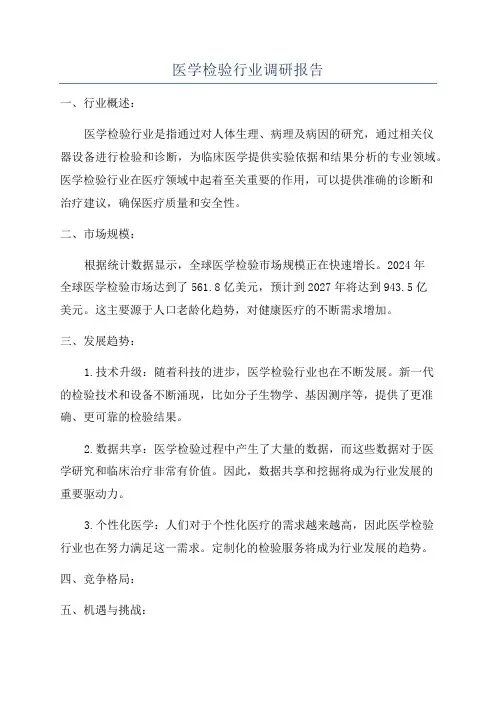
医学检验行业调研报告一、行业概述:医学检验行业是指通过对人体生理、病理及病因的研究,通过相关仪器设备进行检验和诊断,为临床医学提供实验依据和结果分析的专业领域。
医学检验行业在医疗领域中起着至关重要的作用,可以提供准确的诊断和治疗建议,确保医疗质量和安全性。
二、市场规模:根据统计数据显示,全球医学检验市场规模正在快速增长。
2024年全球医学检验市场达到了561.8亿美元,预计到2027年将达到943.5亿美元。
这主要源于人口老龄化趋势,对健康医疗的不断需求增加。
三、发展趋势:1.技术升级:随着科技的进步,医学检验行业也在不断发展。
新一代的检验技术和设备不断涌现,比如分子生物学、基因测序等,提供了更准确、更可靠的检验结果。
2.数据共享:医学检验过程中产生了大量的数据,而这些数据对于医学研究和临床治疗非常有价值。
因此,数据共享和挖掘将成为行业发展的重要驱动力。
3.个性化医学:人们对于个性化医疗的需求越来越高,因此医学检验行业也在努力满足这一需求。
定制化的检验服务将成为行业发展的趋势。
四、竞争格局:五、机遇与挑战:1.政策支持:国家对医学检验行业的政策支持将为行业的持续发展提供机遇。
2.人才短缺:医学检验行业对高素质的人才需求量大,而目前的人才短缺状况也是行业面临的一大挑战。
3.市场需求:随着人们健康意识的提高和医疗服务水平的提升,对于医学检验的需求不断增加。
这为行业带来了巨大的市场机遇。
六、建议:1.加大科研投入:医学检验行业需要不断创新和提升技术水平,加大科研投入,推动行业的发展。
2.加强人才培养:为了解决人才短缺问题,行业需要加大人才培养的力度,培养更多高素质的医学检验专业人才。
3.加强合作交流:医学检验行业不同的机构之间需要加强合作交流,共享资源和数据,共同推动行业的发展。
总结:医学检验行业是医疗领域中不可或缺的一部分,市场规模持续增长。
行业将面临着技术升级、数据共享等发展趋势,同时也面临着人才短缺、竞争激烈等挑战。
我国检验医学的现状与未来
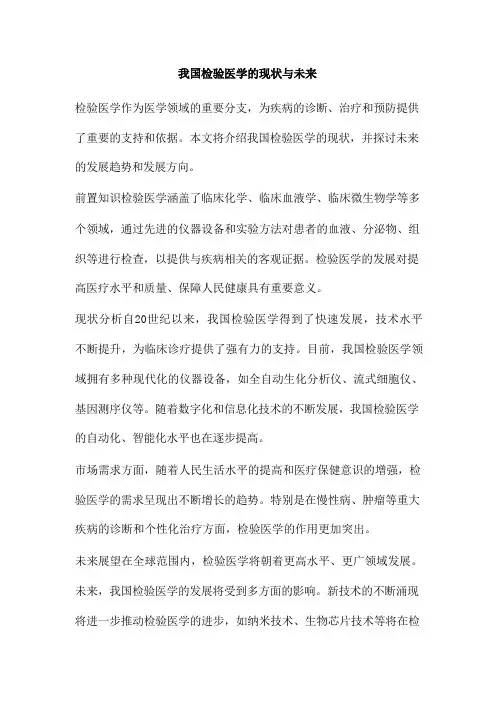
我国检验医学的现状与未来检验医学作为医学领域的重要分支,为疾病的诊断、治疗和预防提供了重要的支持和依据。
本文将介绍我国检验医学的现状,并探讨未来的发展趋势和发展方向。
前置知识检验医学涵盖了临床化学、临床血液学、临床微生物学等多个领域,通过先进的仪器设备和实验方法对患者的血液、分泌物、组织等进行检查,以提供与疾病相关的客观证据。
检验医学的发展对提高医疗水平和质量、保障人民健康具有重要意义。
现状分析自20世纪以来,我国检验医学得到了快速发展,技术水平不断提升,为临床诊疗提供了强有力的支持。
目前,我国检验医学领域拥有多种现代化的仪器设备,如全自动生化分析仪、流式细胞仪、基因测序仪等。
随着数字化和信息化技术的不断发展,我国检验医学的自动化、智能化水平也在逐步提高。
市场需求方面,随着人民生活水平的提高和医疗保健意识的增强,检验医学的需求呈现出不断增长的趋势。
特别是在慢性病、肿瘤等重大疾病的诊断和个性化治疗方面,检验医学的作用更加突出。
未来展望在全球范围内,检验医学将朝着更高水平、更广领域发展。
未来,我国检验医学的发展将受到多方面的影响。
新技术的不断涌现将进一步推动检验医学的进步,如纳米技术、生物芯片技术等将在检验医学中得到广泛应用。
随着医疗体制改革的深入推进,检验医学将更加注重质量控制和成本控制,以提高医疗资源的利用效率。
随着个性化医疗和精准医疗的发展,检验医学将更加基因检测、免疫检测等领域的发展,为患者提供更加全面的诊疗服务。
总结检验医学在我国医疗事业中发挥着重要作用,其发展水平直接关系到人民的健康水平。
目前,我国检验医学在仪器设备、技术水平方面取得了长足进步,为临床诊疗提供了有力支持。
未来,随着新技术的不断涌现和医疗体制改革的深入推进,我国检验医学将朝着更高水平、更广领域发展,为人民的健康事业做出更大的贡献。
在面对检验医学的未来发展时,我们应该充分认识到前置知识的重要性,不断加强技术研发和创新,推动我国检验医学的持续进步。
检验医学的现状和展望
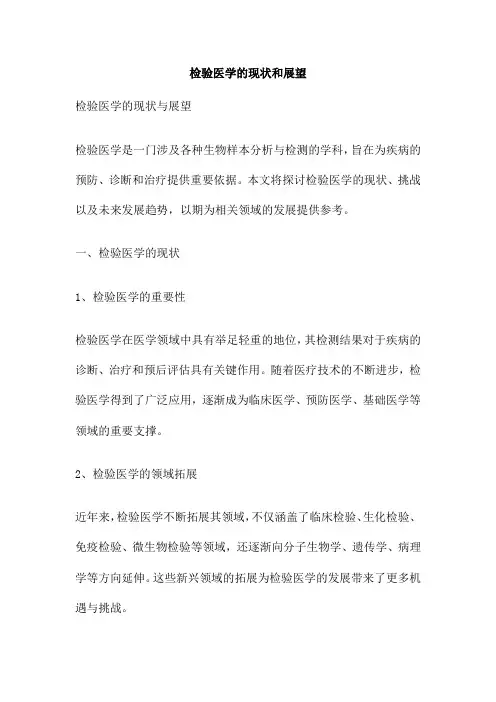
检验医学的现状和展望检验医学的现状与展望检验医学是一门涉及各种生物样本分析与检测的学科,旨在为疾病的预防、诊断和治疗提供重要依据。
本文将探讨检验医学的现状、挑战以及未来发展趋势,以期为相关领域的发展提供参考。
一、检验医学的现状1、检验医学的重要性检验医学在医学领域中具有举足轻重的地位,其检测结果对于疾病的诊断、治疗和预后评估具有关键作用。
随着医疗技术的不断进步,检验医学得到了广泛应用,逐渐成为临床医学、预防医学、基础医学等领域的重要支撑。
2、检验医学的领域拓展近年来,检验医学不断拓展其领域,不仅涵盖了临床检验、生化检验、免疫检验、微生物检验等领域,还逐渐向分子生物学、遗传学、病理学等方向延伸。
这些新兴领域的拓展为检验医学的发展带来了更多机遇与挑战。
3、检验医学的技术进步随着科技的不断进步,检验医学技术也得到了大力发展。
新型检测技术如基因测序、质谱技术、液相色谱-串联质谱等逐渐应用于检验医学领域,使得检测的精度和效率得到了极大提高。
二、检验医学的未来发展趋势1、个性化医疗的推动随着个性化医疗的发展,未来的检验医学将更加注重患者的基因、表型等个性化特征,为患者提供更加精准的治疗方案。
基因检测等个性化医疗技术的广泛应用,将为检验医学带来更多的发展机遇。
2、人工智能的应用人工智能技术的发展为检验医学带来了新的突破口。
未来,人工智能将在实验室管理、数据分析、疾病预测等方面发挥重要作用,提高检验医学的智能化水平,为医生提供更加精准、及时的诊断信息。
3、生物标志物的发现与应用未来,检验医学将致力于发现新的生物标志物,以便更早地预测和治疗疾病。
这些生物标志物可能涉及基因、蛋白质、代谢物等,它们的发现将为检验医学带来更多的研究课题和临床应用价值。
三、结论检验医学在医学领域中的地位日益凸显,其发展对于疾病的预防、诊断和治疗具有重要意义。
随着科技的不断进步和个性化医疗的发展,检验医学将朝着更高精度、更高效率、更个性化的方向发展。
医学检验技术发展现状和未来趋势

医学检验技术发展现状和未来趋势医学检验技术啊,就像一个超级侦探,在人体这个神秘的大案子里到处找线索。
现在呢,这个侦探已经有了不少厉害的工具。
你看,那些高精尖的仪器就像一群超级英雄。
比如说基因测序仪,那简直就是能看透基因密码的“X战警”,轻轻一扫描,基因里的小秘密就无处遁形了。
而且现在的检验速度那叫一个快,就像闪电侠一样,以前等检验结果像等蜗牛爬,现在嗖的一下就出来了。
不过,现在的医学检验技术也有点小脾气呢。
就像一个有点傲娇的学霸,有些仪器特别复杂,操作起来就像走迷宫一样,一个不小心就可能出错。
而且啊,检验的费用有时候也高得像坐火箭,让一些患者望而却步。
再看看样本采集,就像一场奇特的寻宝游戏。
护士姐姐们像勇敢的探险家,从患者身上找到合适的样本。
有时候采个血就像和小血管玩捉迷藏,尤其是那些血管特别细的人,可真是让护士姐姐们费了不少劲儿。
但未来就不一样啦,那简直是充满了魔法。
医学检验技术可能会变得像哈利·波特的魔法棒一样神奇。
也许会有那种能直接在身体表面就进行检测的仪器,不需要再扎针抽血啦,这就好比直接透过水晶球看身体内部的情况一样酷。
还有啊,未来的检验技术可能会超级智能。
就像拥有一个全知全能的大脑,能自动分析所有的检验结果,还能预测疾病的发展趋势。
到时候医生们就像有了一个超得力的助手,再也不用为那些复杂的数据发愁了。
而且我猜啊,未来的检验技术会越来越微型化。
说不定能做出像蚂蚁一样小的检验设备,可以直接放到身体里去监测身体的各种变化,就像体内住了一群小小的健康守护者。
数据共享也会像一场盛大的联欢晚会。
各个医院的检验数据可以轻松地交流分享,不再像现在这样各自为政,这样就可以让医生们得到更全面的信息,更好地治病救人啦。
在人才培养方面呢,未来的医学检验技术人员就像一群超级魔法师学徒,要掌握更多更神奇的技能。
不仅要懂技术,还要能和那些智能设备和谐共处。
医学检验技术的现在虽然有点小毛病,但未来可是充满了无限的可能。
2024年医学检验市场前景分析
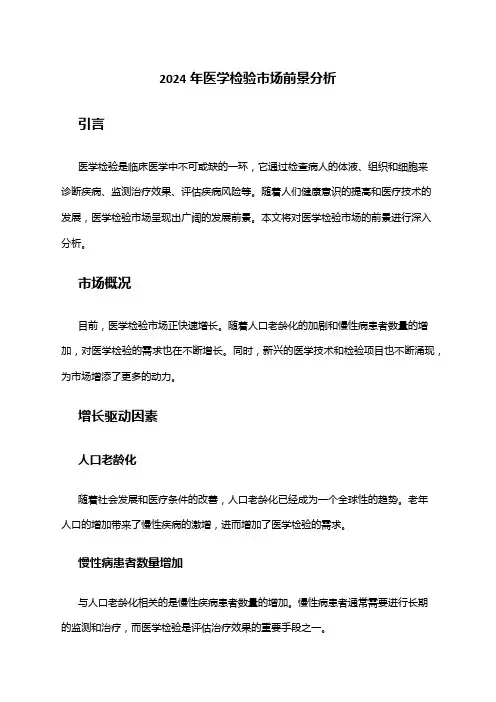
2024年医学检验市场前景分析引言医学检验是临床医学中不可或缺的一环,它通过检查病人的体液、组织和细胞来诊断疾病、监测治疗效果、评估疾病风险等。
随着人们健康意识的提高和医疗技术的发展,医学检验市场呈现出广阔的发展前景。
本文将对医学检验市场的前景进行深入分析。
市场概况目前,医学检验市场正快速增长。
随着人口老龄化的加剧和慢性病患者数量的增加,对医学检验的需求也在不断增长。
同时,新兴的医学技术和检验项目也不断涌现,为市场增添了更多的动力。
增长驱动因素人口老龄化随着社会发展和医疗条件的改善,人口老龄化已经成为一个全球性的趋势。
老年人口的增加带来了慢性疾病的激增,进而增加了医学检验的需求。
慢性病患者数量增加与人口老龄化相关的是慢性疾病患者数量的增加。
慢性病患者通常需要进行长期的监测和治疗,而医学检验是评估治疗效果的重要手段之一。
新兴技术的推动随着科技的进步,越来越多的新兴技术被应用于医学检验领域,提高了检验的准确性和可靠性。
例如,基因检测、代谢组学等技术的应用,为医学检验市场增添了新的增长点。
市场机会与挑战机会1.市场规模扩大:随着医学检验需求的增加,市场规模将进一步扩大。
2.技术创新的推动:新兴技术的应用将为市场带来更多的机会,提高检验的准确性和可靠性。
挑战1.竞争压力增加:随着市场的扩大,竞争压力将进一步增加,要想在市场中立于不败之地需要具备竞争力的服务和品质。
2.监管要求的提高:医学检验涉及到病人的生命健康,监管要求也越来越高,医学检验机构需要不断提升自身管理和质量水平。
发展趋势个性化医学检验个性化医学是未来医学发展的一个重要方向,而医学检验正是个性化医学的基石。
个性化医学将根据个体的遗传信息、生活习惯、环境等因素进行定制化的治疗和检验,这也将带来医学检验市场的新机遇。
互联网+医学检验互联网的发展改变了人们的生活方式,也对医学检验市场带来了新的机遇。
互联网技术可以实现远程医学检验、在线咨询和报告查询等功能,提高了检验的便捷性和效率。
临床医学检验的现状及发展趋势展望
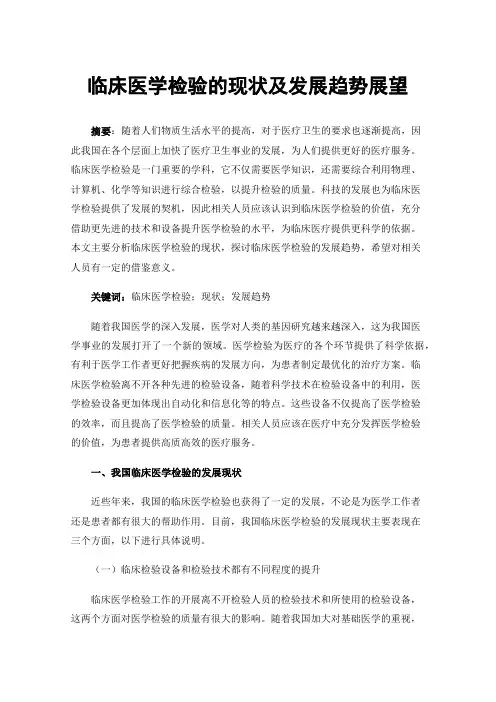
临床医学检验的现状及发展趋势展望摘要:随着人们物质生活水平的提高,对于医疗卫生的要求也逐渐提高,因此我国在各个层面上加快了医疗卫生事业的发展,为人们提供更好的医疗服务。
临床医学检验是一门重要的学科,它不仅需要医学知识,还需要综合利用物理、计算机、化学等知识进行综合检验,以提升检验的质量。
科技的发展也为临床医学检验提供了发展的契机,因此相关人员应该认识到临床医学检验的价值,充分借助更先进的技术和设备提升医学检验的水平,为临床医疗提供更科学的依据。
本文主要分析临床医学检验的现状,探讨临床医学检验的发展趋势,希望对相关人员有一定的借鉴意义。
关键词:临床医学检验;现状;发展趋势随着我国医学的深入发展,医学对人类的基因研究越来越深入,这为我国医学事业的发展打开了一个新的领域。
医学检验为医疗的各个环节提供了科学依据,有利于医学工作者更好把握疾病的发展方向,为患者制定最优化的治疗方案。
临床医学检验离不开各种先进的检验设备,随着科学技术在检验设备中的利用,医学检验设备更加体现出自动化和信息化等的特点。
这些设备不仅提高了医学检验的效率,而且提高了医学检验的质量。
相关人员应该在医疗中充分发挥医学检验的价值,为患者提供高质高效的医疗服务。
一、我国临床医学检验的发展现状近些年来,我国的临床医学检验也获得了一定的发展,不论是为医学工作者还是患者都有很大的帮助作用。
目前,我国临床医学检验的发展现状主要表现在三个方面,以下进行具体说明。
(一)临床检验设备和检验技术都有不同程度的提升临床医学检验工作的开展离不开检验人员的检验技术和所使用的检验设备,这两个方面对医学检验的质量有很大的影响。
随着我国加大对基础医学的重视,大量的先进科技应用在医学检验中,这一方面改进提升了检验技术,另一方面促使医学检验设备的更新升级。
在这种情况下,医疗检验将会发挥出更大的作用。
(二)临床医学检验人员的专业素质得到明显的提升人民大众对医疗水平的要求逐步提高,也促使我国医疗事业的不断发展。
2024年医学检验所市场环境分析
2024年医学检验所市场环境分析引言医学检验所作为医疗卫生体系中不可或缺的一环,承担着疾病诊断、预防、监测和科学研究等重要职责。
作为一个服务行业,医学检验所的市场环境对其发展至关重要。
本文旨在分析医学检验所的市场环境,为其发展提供参考。
1. 宏观环境分析1.1 经济因素经济因素是影响医学检验所市场环境的重要因素之一。
随着经济发展水平的提高和人民收入的增加,人们对健康的需求也越来越高。
因此,医学检验所的市场需求将随之增加。
另外,医学检验服务的价格也是影响市场需求的因素之一,在经济繁荣时期,人们更愿意接受更多的医学检验服务。
1.2 政策因素政策因素对医学检验所市场环境的影响不可忽视。
政府相关政策的制定和执行将对医学检验所的运营和发展产生重要影响。
政府的支持和监管政策有助于提高医学检验所的行业标准和质量,同时也会促进医学检验所的市场竞争力。
1.3 社会因素社会因素也是影响医学检验所市场环境的重要因素。
随着人口老龄化和慢性疾病的增加,人们对医疗和健康的需求也相应增加。
此外,健康意识的提高和疾病预防观念的普及也促进了医学检验所的发展。
社会对医学检验所的信任度和需求量将直接影响市场竞争局势。
2. 行业环境分析2.1 竞争情况医学检验所所处的竞争环境较为激烈。
一个地区可能有多家医学检验所提供类似的服务,竞争压力较大。
在竞争激烈的环境下,医学检验所需要通过提高服务质量、技术水平和降低价格来提升市场竞争力。
2.2 技术因素医学检验所的核心竞争力在于技术水平。
随着科技的进步,医学检验所需要不断更新设备和学习新技术,保持技术的先进性和准确性。
同时,技术的快速发展也提供了更多的可能性,例如基因检测和分子诊断等新兴技术的应用,给医学检验所带来新的发展机遇。
2.3 市场需求市场需求是医学检验所发展的基础。
随着人们健康需求和健康观念的提高,市场对医学检验所的需求也将不断增长。
根据需求的变化,医学检验所可以开发新的检验项目和服务,以满足市场的需求。
2023年医学检验行业分析报告及未来五至十年行业发展报告
医学检验行业分析报告及未来五至十年行业发展报告目录序言 (5)一、医学检验企业战略选择 (5)(一)、医学检验行业SWOT分析 (5)(二)、医学检验企业战略确定 (6)(三)、医学检验行业PEST分析 (7)1、政策因素 (7)2、经济因素 (7)3、社会因素 (8)4、技术因素 (8)二、医学检验行业政策背景 (9)(一)、政策将会持续利好医学检验行业发展 (9)(二)、医学检验行业政策体系日趋完善 (9)(三)、医学检验行业一级市场火热,国内专利不断攀升 (10)(四)、宏观经济背景下医学检验行业的定位 (10)三、2023-2028年医学检验产业发展战略分析 (11)(一)、树立医学检验行业“战略突围”理念 (11)(二)、确定医学检验行业市场定位,产品定位和品牌定位 (11)1、市场定位 (11)2、产品定位 (12)3、品牌定位 (13)(三)、创新力求突破 (14)1、基于消费升级的技术创新模型 (14)2、创新促进医学检验行业更高品质的发展 (15)3、尝试格式创新和品牌创新 (16)4、自主创新+品牌 (17)(四)、制定宣传方案 (18)1、学会制造新闻,事件行销--低成本传播利器 (18)2、学习通过出色的品牌视觉设计突出品牌特征 (18)3、学会利用互联网营销 (19)四、2023-2028年宏观政策背景下医学检验业发展现状 (19)(一)、2022年医学检验业发展环境分析 (19)(二)、国际形势对医学检验业发展的影响分析 (20)(三)、医学检验业经济结构分析 (21)五、医学检验行业财务状况分析 (22)(一)、医学检验行业近三年财务数据及指标分析 (22)(二)、现金流对医学检验业的影响 (25)六、医学检验行业竞争分析 (25)(一)、医学检验行业国内外对比分析 (26)(二)、中国医学检验行业品牌竞争格局分析 (27)(三)、中国医学检验行业竞争强度分析 (27)1、中国医学检验行业现有企业竞争情况 (27)2、中国医学检验行业上游议价能力分析 (27)3、中国医学检验行业下游议价能力分析 (28)4、中国医学检验行业新进入者威胁分析 (28)5、中国医学检验行业替代品威胁分析 (28)(四)、初创公司大独角兽领衔 (28)(五)、上市公司双雄深耕多年 (29)(六)、医学检验巨头综合优势明显 (30)七、医学检验行业竞争分析 (30)(一)、医学检验行业国内外对比分析 (30)(二)、中国医学检验行业品牌竞争格局分析 (31)(三)、中国医学检验行业竞争强度分析 (32)1、中国医学检验行业现有企业的竞争 (32)2、中国医学检验行业上游议价能力分析 (32)3、中国医学检验行业下游议价能力分析 (32)4、中国医学检验行业新进入者威胁分析 (33)5、中国医学检验行业替代品威胁分析 (33)八、医学检验业突破瓶颈的挑战分析 (33)(一)、医学检验业发展特点分析 (33)(二)、医学检验业的市场渠道挑战 (34)(三)、医学检验业5-10年创新发展的挑战点 (34)1、医学检验业纵向延伸分析 (34)2、医学检验业运营周期的挑战分析 (35)九、未来医学检验企业发展的战略保障措施 (35)(一)、根据公司发展阶段及时调整组织结构 (35)(二)、加强人才培养和引进 (36)1、制定总体人才引进计划 (36)2、渠道人才引进 (37)3、内部员工竞聘 (37)(三)、加速信息化建设步伐 (38)十、医学检验成功突围策略 (38)(一)、寻找医学检验行业准差异化消费者兴趣诉求点 (38)(二)、医学检验行业精准定位与无声消费教育 (39)(三)、从医学检验行业硬文广告传播到深度合作 (39)(四)、公益营销竞争激烈 (40)(五)、电子商务提升医学检验行业广告效果 (40)(六)、医学检验行业渠道以多种形式传播 (40)(七)、强调市场细分,深耕医学检验产业 (41)十一、医学检验行业企业差异化突破战略 (41)(一)、医学检验行业产品差异化获取“商机” (41)(二)、医学检验行业市场分化赢得“商机” (42)(三)、以医学检验行业服务差异化“抓住”商机 (42)(四)、用医学检验行业客户差异化“抓住”商机 (43)(五)、以医学检验行业渠道差异化“争取”商机 (43)序言依据编者的深度调查分析及专业预测,本次行业报告将从下面九个方面全方位对医学检验行业过去的发展情况进行详细的研究与分析,并将对医学检验行业进行专业的未来发展趋势预测,还将对医学检验行业前景进行展望及提出合理化的建议。
医学检验技术的发展现状与未来趋势
医学检验技术的发展现状与未来趋势随着科技的不断进步和医学的发展,医学检验技术在健康检查、疾病诊断和治疗过程中起着越来越重要的作用。
本文将探讨医学检验技术的发展现状以及未来的趋势。
一、医学检验技术的发展现状目前,医学检验技术已经取得了丰硕的成果,并且在临床实践中得到广泛应用。
其中,最常见的检验技术包括生化检验、免疫学检验、遗传学检验等。
这些技术通过对人体内生化指标和分子水平的分析,能够提供疾病的早期诊断以及治疗方案的制定依据。
生化检验是目前医学检验中最常用的一种技术。
通过对血液、尿液和其他生理液体中多种物质的测定,可以获取关于人体健康状态的信息。
例如,血糖、肝功、血脂等指标的检查能够反映出糖尿病、肝功能异常、心血管疾病等常见病的风险。
免疫学检验是另外一种重要的技术。
通过检测人体中的免疫指标,可以评估免疫系统的功能以及对疾病的应对能力。
例如,病毒性感染会引发特定抗体的产生,通过检测这些抗体的水平,可以判断出人体是否已经感染了特定病毒,从而作出相应的治疗决策。
遗传学检验是近年来发展迅速的领域。
通过对基因的检测和分析,可以揭示出潜在的遗传性疾病风险,并为治疗和疾病预防提供重要依据。
例如,基因检测能够检测出某些基因突变,从而提前预知患有某些遗传病的可能性,帮助人们采取相应的预防措施。
除了以上几种常见的技术,还有许多其他新的检验技术在不断涌现。
例如,分子诊断技术可以通过检测人体中微量的特定分子,来判断疾病的存在。
纳米技术结合生物传感器技术可以实现对更小体积的检测样本进行高灵敏度检测。
随着单细胞技术的发展,将能够对个体细胞进行精确的检测和分析,推动个体化医疗的发展。
二、医学检验技术的未来趋势医学检验技术的未来发展将围绕着“准确性”、“敏感性”和“高通量”展开。
在准确性方面,新的检验方法将不断提高检验结果的准确性,尤其是在疾病早期诊断和治疗监测方面。
敏感性是衡量一种检验方法优劣的重要指标。
未来的技术将不断提高对低浓度物质的检测能力和分辨率,从而能够更早地发现疾病的迹象,并进行更精准的治疗。
2024年医学检验所市场前景分析
2024年医学检验所市场前景分析前言医学检验所是一种专门提供医学实验室服务的机构。
它们的主要责任是进行临床化验、研究和诊断,并为医疗机构和其他相关领域提供准确可靠的医学检验服务。
医学检验所在现代医疗体系中扮演着重要的角色,因此了解其市场前景对于投资者和从业人员都非常重要。
市场规模和增长趋势医学检验所市场规模庞大且增长迅速。
根据市场研究机构的数据显示,全球医学检验所市场规模在近几年持续稳定增长,预计将继续保持增长趋势。
其中,亚太地区是医学检验所市场的最大增长区域。
亚太地区的经济增长和人口老龄化是该市场增长的主要驱动因素。
此外,越来越多的人们开始关注个人健康,医学检验所可以提供准确和全面的检测服务,满足人们对健康的需求。
另外,随着医疗技术的不断发展,医学检验所将面临新的机遇。
例如,基因检测和精准医疗等新兴领域的快速发展,为医学检验所带来了更多的业务机会。
市场竞争格局医学检验所市场竞争激烈,主要的竞争对手包括大型医疗机构、国际连锁实验室和本地小型实验室。
这些竞争对手在设备、技术和服务质量方面都有一定的优势。
大型医疗机构通常具有较高的设备投资和技术实力,能够提供更全面、复杂的医学检验服务。
国际连锁实验室则通过跨地区扩展和标准化服务来获得竞争优势。
本地小型实验室则通常通过价格竞争以及提供个性化的服务来与大型竞争对手进行竞争。
此外,政府监管和行业准入门槛也是影响市场竞争格局的因素之一。
在一些国家或地区,设立医学检验所需要遵守一定的法规和标准,这提高了进入市场的门槛,对竞争形成一定的限制。
市场发展趋势技术进步和创新随着科技的不断进步,医学检验技术也在不断发展和创新。
新技术的应用使得医学检验所能够在更短的时间内提供更准确的检测结果。
例如,基因测序技术的进步为个性化医学提供了更多可能,并为医学检验所带来了更多的业务机会。
服务多样化和个性化需求随着人们对健康的关注度提高,他们对医学检验所的要求也日益多样化和个性化。
- 1、下载文档前请自行甄别文档内容的完整性,平台不提供额外的编辑、内容补充、找答案等附加服务。
- 2、"仅部分预览"的文档,不可在线预览部分如存在完整性等问题,可反馈申请退款(可完整预览的文档不适用该条件!)。
- 3、如文档侵犯您的权益,请联系客服反馈,我们会尽快为您处理(人工客服工作时间:9:00-18:30)。
中国医学检验发展的现状和展望
发表时间:2019-04-08T11:30:29.180Z 来源:《中国研究型医院》2018年5卷5期作者:高中凯
[导读] 检验准备阶段、标本采集阶段和标本处理阶段重点影响医学检验质量,要对影响因素进行统计分析,并制定针对性的应对措施以保证医学检验质量。
黑龙江省伊春市中心医院 153000
摘要:目的:探究中国医学检验发展的现状,并就现状提出建议,对中国医学检验发展进行展望。
方法:选取我院2017年10月-2018年4月进行医学检验的56例患者作为研究样本,分析在不同阶段的患者临床检验结果失误率,就此分析影响医学检验质量控制的因素,对医学检验发展现状整体把握、提出医学检验未来发展趋势的构想。
结果:56例患者共进行98次医学检验,检验失误率为14.28%,检验准备阶段、标本采集阶段和标本处理阶段的失误率分别是5.28%、5.26%和3.23%。
结论:检验准备阶段、标本采集阶段和标本处理阶段重点影响医学检验质量,要对影响因素进行统计分析,并制定针对性的应对措施以保证医学检验质量。
关键词:医学检验;质量控制;现状及发展
The status quo and prospect of the development of medical inspection in China
Abstract: Objective: To explore the current situation of the development of medical examination in China, and to make recommendations on the status quo, and to prospect the development of medical inspection in China. Methods: 56 patients who underwent medical examination from October 2017 to April 1818 in our hospital were selected as research samples to analyze the error rate of clinical test results in different stages of patients. In this paper, the factors affecting the quality control of medical tests were analyzed. The overall status of development is grasped and the concept of medical development for future development is proposed. results: A total of 98 medical examinations were performed in 56 patients. The error rate was 14.28%. The error rates in the preparation preparation phase, specimen collection phase and specimen processing phase were 5.28%, 5.26% and 3.23%, respectively. Conclusion: The test preparation stage, specimen collection stage and specimen processing stage mainly affect the quality of medical examination, statistical analysis should be carried out on the influencing factors, and targeted countermeasures should be formulated to ensure the quality of medical examination.
Keywords: medical test; quality control; status quo and development
临床医学检验是对取自人体的材料进行一系列检验,从而为预防、诊断、治疗人体疾病或对人体健康进行评估服务,它是医学诊断及治疗的重要基础。
在医学检验的具体实施过程中,检验前期准备工作、样本采集方法、样本处理手段等因素都与检验的质量密切相关[1]。
分析影响临床医学检验质量的因素从不同阶段和不同角度出发,抓住医学检验质量控制的重心,并在此基础上,通过科学方法对影响医学检验的因素进行控制,顺应临床检验医学不断发展的趋势。
1资料与方法
1.1一般资料
选取医院2017年10月至2018年4月进行临床医学检验的56例患者作为研究对象,对患者的98次临床医学检验材料进行研究。
样本中的56例患者中
男32例,女24例;年龄为16-67岁,平均38-52岁。
患者的基本资料者经统计学处理比较,无显著性差异(P>0.05)。
98次临床医学检验包括血液检验45次,生化检验16次,尿沉渣检验18次,便分析检验19次。
1.2方法
临床检验、免疫、微生物、生化、血液等不同科室按照临床医学检验的相关标准对患者实施医学检验:血液生化检验前一周对患者进行禁烟禁酒,并合理控制患者对高脂肪饮食的摄入;患者要在在抽血检验前12小时保持空腹状态,检验前6小时内避免剧烈有氧运动。
检验工作全程由专业检验人员按照相关规范步骤进行检验,同时医护人员要对患者信息资料以及检验标本进行严格管理。
1.3观察指标
收集所有临床检验样本,重点分析发生临床检验失误的标本信息,对质量控制的影响要素进行分析。
检验过程中,标本损坏以及丢失,判定为检验失误;由于其他因素的影响,出现检验失效的状况,判定为检验失误。
经临床医学检验结果与预期结果的对比差异十分明显,需进行二次检验,注意对第一次检验结果进行重复检验,判定一次检验结果是否失误。
1.4统计学方法
采取SPSS软件包进行统计学分析,计量资料用均数±标准差(x±s)表示,采用t检验和χ2检验,P<0.05为差异有统计学意义。
2结果
根据统计结果,56例患者共进行98次医学检验,检验失误率为13.77%,影响临床医学检验质量控制的因素的主要阶段是:检验准备阶段、标本采集阶段和标本处理阶段,失误率分别是5.28%、5.26%和3.23%。
如下表:
3讨论
尽管随着检验设备与技术的不断更新,医学检验的质量与管理水平也在不断的优化,检测结果的准确率达到较高的水平,但在医学检验过程中,影响检验质量的因素主要是两个方面的:受检者和检验实验室。
在医学检验的流程中具体来说,检验准备阶段,受检者对检验质量影响重大,受检者要遵循医嘱,在饮食、作息等多个角度进行准备。
医护人员是否详细告知受检者注意事项,以及受检者是否严格按照注意事项进行准备[2],会对检验结果准确与否产生影响。
在样本采集阶段,所使用的检验设备及检验人员个人素质对检验结果产生重要影响,包括检验技术操作是否符合规范,与受检者沟通与否,是否能够对受检者的情绪进行管控,会对检验的质量产生影响,个人素质有待提高的检验人员增加检验失误发生的可能性。
样本采集的过程中,使用检验设备养护情况,检验人员对检验仪器工作原理掌握牢固与否,是否能够科学准确操作标本的采集、分离、运送与保存、处理等;对常用的试剂配置方法与原理有所掌握程度及对检验结果的分析与判断水平,都会导致检验的结果受到影响。
同时检验人员应当准确记录样本采集的时间、采集部位,加强患者、检验及临床的沟通,保证三方信息的顺畅传递。
综上所述,医院要对症下药,针对在研究中出现的影响临床医学检验质量的因素,从提升检验人员个人素质,加强检验者、检验、临床三方沟通,强化质控等多个角度进行改进,进而降低和避免影响检验质量的因素。
在此基础上,顺应医学检验与合自动化与信息技术、分子生物学技术、标记免疫分析技术[3]等的有机结合的趋势,不断提高医学检测的准确率,为临床提供可靠的数据支持,促进医学诊疗水平。
参考文献:
[1]高礼信.临床医学检验质量控制的影响因素及应对措施[J].医药卫生:文摘版,2016,12(3):296-298.
[2]李萍,杨静波,佟鑫.临床医学检验中质量控制提高的影响因素及措施研究[J].临床医药文献电子杂志,2017,14(86):114-116.
[3]袁祯泷.对临床医学检验质量控制的影响因素分析及应对措施探究[J].科技风,2016,10(18):64-65.。
